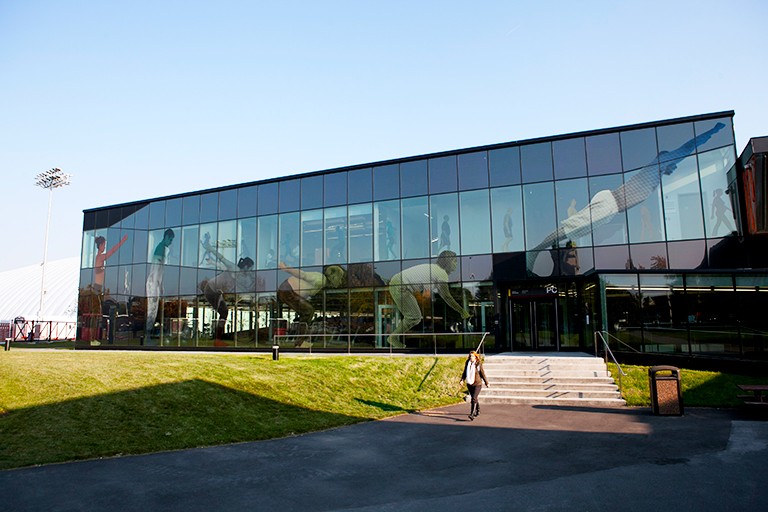Concordia is developing a public art policy — and seeking Concordians’ feedback
 Annie Gérin: “Often public art is used to make visible processes or practices that are behind the walls of the building. Adad Hannah’s ‘Leap’ (2011) is a really really good case of this.”
Annie Gérin: “Often public art is used to make visible processes or practices that are behind the walls of the building. Adad Hannah’s ‘Leap’ (2011) is a really really good case of this.”
Concordia is developing a new public art policy that will govern its current public art collection, future acquisitions and ephemeral art programming and provide a framework for its governance.
Today, Concordia’s collection features more than 40 artists and is presented across both the Sir George Williams and Loyola campuses on building facades, city sidewalks, the university’s building tunnels and atria.
The eclectic public art collection is composed of permanent, mostly large-scale artworks that date from approximately the 1930s to the present. The collection spans traditional to contemporary art practices and features everything from abstract to figurative paintings, traditional bronze busts, kinetic sculpture, large-scale photographs and glass artworks.
The newest sculpture by Marc-Antoine Coté — installed at the Applied Science Hub on Loyola Campus — stands two storeys tall and is made from 2,700 kilograms of metal, mainly aluminum.
Responding to a ‘global cultural shift’
The new public art policy will provide a framework and vision for governance and decision-making processes and encourage diverse representation within the university’s collection and programming activities. The policy will aim to ensure equitable and inclusive practices that represent the diversity of Concordia and the general public. It will also help define and expand what public art is at the university.
“The development of the public art policy is an important project for Concordia and the Library”, says Guylaine Beaudry, university librarian. “The ongoing conversations with the community about the policy and the feedback that is received will help inform and enrich its framework through a diversity of voices and viewpoints.”
Sandra Margolian, Concordia’s public art lead, is managing the development of the public art policy with the assistance of consulting firm Communications MDR and the input from key diverse internal and external community stakeholders. In addition, the policy will specify a mandate and detail terms of reference for a public art advisory committee.
“For the past several years, discussions have been taking place within art institutions about the inequities present in the methods of acquisition, representation and decision-making processes,” Margolian says.
“The Truth and Reconciliation Commission’s Calls to Action and the Black Lives Matter movement are encouraging the re-evaluation of museum policies and practices. This has motivated — mobilized — the arts community and it’s institutions to question how they can take stock of and address institutional racism and ensure equitable and inclusive practices in the development, presentation and governance of their collections.”
Margolian adds that the resulting global cultural shift, also occurring at Concordia, is what’s allowing the university’s public art policy project to happen now.
Some of the key objectives of the policy include:
- Providing a formal framework to govern the development and conservation of the collection, including a clear mission and curatorial vision
- Expanding engagement and pedagogical opportunities with the collection for all of Concordia’s diverse communities — students, faculty, staff and the general public
- Ensuring inclusive best practices, taking into consideration the university’s location on unceded Indigenous lands; Concordia’s Indigenous Directions Action Plan provides an important foundation for this
- Providing direction for making appraisals and acquisition decisions, allocating resources and creating accountability
- Ensuring best practices and funding in caring for permanent works as well as programming ephemeral art
- Providing opportunities for Concordia’s fine arts students to gain experience in creating public and socially engaged artwork while at the university
The multiple roles of a university public art collection
The university’s 4TH SPACE recently hosted a podcast conversation between Margolian and Annie Gérin, Concordia’s dean of fine arts and art historian. Gérin’s research focuses on public art, specifically Canadian and Soviet art and how it is experienced outside of traditional gallery spaces. The two speakers bring to light the multiple roles of a university public art collection.
They point out that, in addition to serving as a pedagogical resource, the collection can activate public space aesthetically and culturally, contribute to community identity, reflect or critique the space it inhabits and be a starting point to engage in conversation with the university community.
The policy is being developed with input from the community. Interviews with key internal and external stakeholders are currently being conducted and will be followed by broader community consultations to take place over the fall term.
Those interested in participating in community consultations can sign up on Concordia’s public art policy page.
Learn more about Concordia’s public art policy project and participate in the community consultations.


